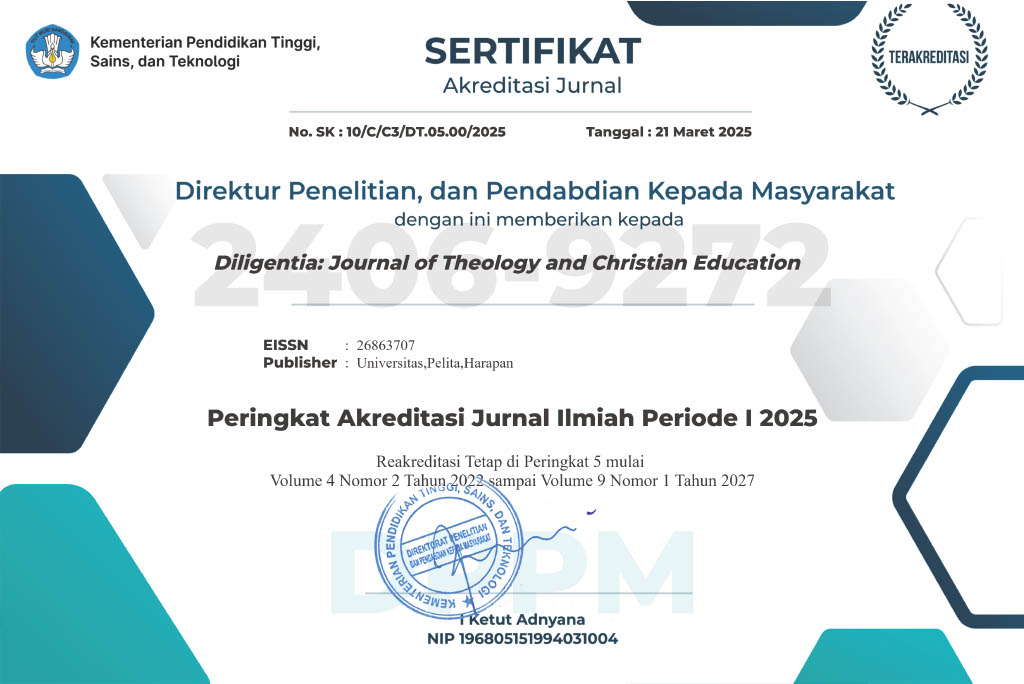Memahami Cinta, Kesetiaan, dan Hubungan Manusia dengan Tuhan dalam Kitab Kidung Agung: Sebuah Analisis Stilistika Simbol dan Metafora [Understanding Love, Faithfulness, and the Human Relationship with God in the Book of Song of Songs: A Stylistic Analysis of Symbols and Metaphors]
Sebuah Analisis Stilistika Simbol dan Metafora
DOI:
https://doi.org/10.19166/dil.v7i3.7899Keywords:
love, loyalty, metaphor, relationship between human and God, symbolAbstract
This study aims to understand the meaning of love, loyalty, and the relationship between human and God as revealed in the Book Song of Songs through a stylistic approach, especially the analysis of symbols and metaphors. The Book Song of Songs, which is rich in poetic language, is often interpreted not only as an expression of love between humans, but also as an allegory of the otherworldly relationship between humans and God. This study uses a qualitative descriptive method with text analysis techniques to identify and interpret the dominant symbols and metaphors in the text. The results of the analysis show that symbols such as gardens, grapes, flowers, and certain animals depict beauty, intimacy, and deep longing between lovers and loved ones, which in a theological context can be interpreted as a representation of the otherworldly relationship between human and God. The metaphor of love is also used to explain loyalty and pure devotion. This paper also emphasizes that the Book Song of Songs is not only a love poem but also has a deep theological meaning of a transcendental relationship. In addition, this book teaches that true love is a gift from God, and that you must live with commitment and respect. By understanding the symbols and metaphors used, readers are invited to think about the spiritual dimensions of love and loyalty in relationships between human and God.
References
Firdaus, Lylyan, and Agus Prayitno. “Makna Berpacaran yang Benar menurut Kidung Agung 8:6.” FILADELFIA: Jurnal Teologi dan Pendidikan Kristen 2, no. 2 (October 2021): 249–63. https://doi.org/10.55772/filadelfia.v2i2.43.
Herin, Falentino Gega Herin. “Relasi antara Allah dan Manusia dalam Kidung Agung.” SAMI: Jurnal Sosiologi Agama dan Teologi Indonesia 2, no. 1 (June 2024): 111–32. https://doi.org/10.24246/sami.vol2i1pp111-132.
Hill, Andrew E., and John H. Walton. Survei Perjanjian Lama. Translated by Triyogo Setyatmoko. Malang, Indonesia: Gandum Mas, 2019.
Kelelufna, Jusuf Haries. “Analisis Bahasa Kitab Kidung Agung: Suatu Upaya Melacak Peredaksian.” Dunamis: Jurnal Teologi dan Pendidikan Kristiani 6, no. 1 (October 2021): 65–86, https://doi.org/10.30648/dun.v6i1.438.
Kelelufna, Jusuf Haries. “Benarkah Cinta Kuat seperti Maut? Eksegesis Kidung Agung 8:6-7 dan Relevansinya.” Evangelikal: Jurnal Teologi Injili dan Pembinaan Warga Jemaat 5, no. 1 (January 2021): 1–15. https://doi.org/10.46445/ejti.v5i1.321.
Keraf, Gorys. Diksi dan Gaya Bahasa. Jakarta: Gramedia Pustaka Utama, 2009.
LaSor, William Sanford, David Allan Hubbard, and Frederic William Bush. Pengantar Perjanjian Lama 2: Sastra dan Nubuat. Translated by Lisda T. Gamadhi and Lily W. Tjiputra. Jakarta: BPK Gunung Mulia, 1994.
Prabowo, Paulus Dimas. “Kajian Didaktis mengenai Cinta Lelaki dan Wanita dalam Kidung Agung.” HUPERETES: Jurnal Teologi dan Pendidikan Kristen 2, no. 1 (December 2020): 1–13. https://doi.org/10.46817/huperetes.v2i1.28.
Prabowo, Paulus Dimas. “Ragam Penafsiran Kitab Kidung Agung.” Preprint, OSF, 2019. https://doi.org/10.17605/OSF.IO/GA34V.
Purbani, Widyastuti. “Metode Penelitian Sastra.” Jurnal Universitas Negeri Yogyakarta (2010): 1–13. https://www.academia.edu/download/38996322/metode-penelitian-susastra.pdf.
Sambeta, Intan Falensia, I Gede Agus Z. P., and Ray Arnawijaya Riko. “Makna Ungkapan “Jangan Kamu Membangkitkan dan Menggerakkan Cinta sebelum Diingininya (Kidung Agung 2: 7b)” dan Implementasinya bagi Pasangan Pranikah.” Jurnal Iluminasi 2, no. 2 (October 2024): 15–25, https://doi.org/10.71401/iluminasi.v2i2.33.
Santoso, Agus. Cinta Kuat seperti Maut: Tafsir Kitab Kidung Agung. Cianjur, Indonesia: STT Cipanas Press, 2014.
Saras, Tresno. Anggur: Keindahan Rasa, Kesehatan, dan Budaya. Semarang, Indonesia: Tiram Media, 2023.
Sopacoly, Mick Mordekhai. “Merayakan Cinta berdasarkan Kidung Agung 1:9-17.” Dunamis: Jurnal Teologi dan Pendidikan Kristiani 4, no. 2 (April 2020): 234–53. https://doi.org/10.30648/dun.v4i2.290.
Thomas, Art Semuel, and Agus Santoso. Kekasihku Kepunyaanku, dan Aku Kepunyaan Dia: Kidung Agung sebagai Kumpulan Lagu Cinta. Yogyakarta, Indonesia: WR Publishing, 2019.
Thomas, Art Semuel, and Agus Santoso. Pengantar kepada Struktur Perjanjian Lama. Yogyakarta, Indonesia: Wahana Resolusi, 2017.
Tiwery, Weldemina Yudit. “Desire of Love: Menafsir Kidung Agung 7:10-8:4.” Gema Teologi 39, no. 1 (April 2015): 1–14. https://journal-theo.ukdw.ac.id/index.php/gema/article/view/190
Tjia, Johnny, and Barry van der Schoot, eds. Tafsiran Matthew Henry: Kitab Pengkhotbah, Kidung Agung. Translated by Herdian Aprilani, Lanny Murtihardjana, Cynthia Sugirun, Lilian Parsaulian, Aryandhito Widhi Nugroho, and Ichwei G. Indra. Surabaya, Indonesia: Penerbit Momentum, 2018. https://download.sabda.org/buku/Tafsiran_MHC/21-22_PL__Pengkhotbah--Kidung-Agung.pdf.
Downloads
Published
How to Cite
Issue
Section
License
Copyright (c) 2025 Pitaya Rahmadi

This work is licensed under a Creative Commons Attribution-ShareAlike 4.0 International License.
Authors who publish with this journal agree to the following terms:
1) Authors retain copyright and grant the journal right of first publication with the work simultaneously licensed under a Creative Commons Attribution License (CC-BY-SA 4.0) that allows others to share the work with an acknowledgement of the work's authorship and initial publication in this journal.
2) Authors are able to enter into separate, additional contractual arrangements for the non-exclusive distribution of the journal's published version of the work (e.g., post it to an institutional repository or publish it in a book), with an acknowledgement of its initial publication in this journal.
3) Authors are permitted and encouraged to post their work online (e.g., in institutional repositories or on their website). The final published PDF should be used and bibliographic details that credit the publication in this journal should be included














